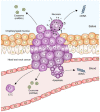Liquid Biopsy in Head and Neck Cancer: Promises and Challenges
- PMID: 29513618
- PMCID: PMC5960882
- DOI: 10.1177/0022034518762071
Liquid Biopsy in Head and Neck Cancer: Promises and Challenges
Abstract
Head and neck cancer is the sixth most common cancer worldwide. It remains one of the leading causes of death, and its early detection is crucial. Liquid biopsy has emerged as a promising tool for detecting and monitoring the disease status of patients with early and advanced cancers. Circulating tumor DNA (ctDNA), circulating tumor cells (CTCs), and exosomal miRNAs have received enormous attention because of their apparent clinical implications. Analyses of these circulating biomarkers have paved the way for novel therapeutic approaches and precision medicine. A growing number of reports have implicated the use of circulating biomarkers for detection, treatment planning, response monitoring, and prognosis assessment. Although these new biomarkers can provide a wide range of possible clinical applications, no validated circulating biomarkers have yet been integrated into clinical practice for head and neck cancer. In this review, we summarize the current knowledge of circulating biomarkers in this field, focusing on their feasibility, limitations, and key areas of clinical applications. We also highlight recent advances in salivary diagnostics and their potential application in head and neck cancer.
Keywords: biomarker; circulating tumor DNA; circulating tumor cell; exosomal miRNA; saliva-exosomics; salivary diagnostics.
Conflict of interest statement
D.T.W. Wong is the cofounder of RNAmeTRIX, a molecular diagnostic company. D.T.W. Wong holds equity in RNAmeTRIX and serves as a company director and scientific advisor. The University of California also holds equity in RNAmeTRIX. Intellectual property that D.T.W. Wong invented and that was patented by the University of California has been licensed to RNAmeTRIX. D.T.W. Wong is a consultant to GlaxoSmithKlein, Wrigley, and Colgate-Palmolive. The authors declare no other potential conflicts of interest with respect to the authorship and/or publication of this article.
Figures


Similar articles
-
Letter to the editor: "Liquid biopsy based on saliva cell-free DNA as a potential biomarker for head and neck cancer".Oral Oncol. 2021 Jan;112:105016. doi: 10.1016/j.oraloncology.2020.105016. Epub 2020 Sep 22. Oral Oncol. 2021. PMID: 32972862 No abstract available.
-
Circulating tumour DNA alterations: emerging biomarker in head and neck squamous cell carcinoma.J Biomed Sci. 2023 Aug 9;30(1):65. doi: 10.1186/s12929-023-00953-z. J Biomed Sci. 2023. PMID: 37559138 Free PMC article. Review.
-
Circulating tumor DNA as a biomarker and liquid biopsy in head and neck squamous cell carcinoma.Head Neck. 2018 Jul;40(7):1598-1604. doi: 10.1002/hed.25140. Epub 2018 Mar 15. Head Neck. 2018. PMID: 29542214 Review.
-
Liquid biopsy and their application progress in head and neck cancer: focus on biomarkers CTCs, cfDNA, ctDNA and EVs.Biomark Med. 2020 Oct;14(14):1393-1404. doi: 10.2217/bmm-2020-0022. Epub 2020 Oct 19. Biomark Med. 2020. PMID: 33073579 Review.
-
Liquid biopsy: An emerging prognostic and predictive tool in Head and Neck Squamous Cell Carcinoma (HNSCC). Focus on Circulating Tumor Cells (CTCs).Oral Oncol. 2017 Nov;74:83-89. doi: 10.1016/j.oraloncology.2017.09.012. Epub 2017 Oct 2. Oral Oncol. 2017. PMID: 29103757 Review.
Cited by
-
Circulating miRNAs as biomarkers for the diagnosis in patients with melanoma: systematic review and meta-analysis.Front Genet. 2024 Feb 14;15:1339357. doi: 10.3389/fgene.2024.1339357. eCollection 2024. Front Genet. 2024. PMID: 38419786 Free PMC article.
-
Salivary Exosome and Cell-Free DNA for Cancer Detection.Micromachines (Basel). 2018 Jul 4;9(7):340. doi: 10.3390/mi9070340. Micromachines (Basel). 2018. PMID: 30424273 Free PMC article. Review.
-
Advanced Polymeric Nanoagents for Oral Cancer Theranostics: A Mini Review.Front Chem. 2022 Jun 14;10:927595. doi: 10.3389/fchem.2022.927595. eCollection 2022. Front Chem. 2022. PMID: 35774863 Free PMC article. Review.
-
A critical analysis of research methods to study clinical molecular biomarkers in Endodontic research.Int Endod J. 2022 Mar;55 Suppl 1(Suppl 1):37-45. doi: 10.1111/iej.13647. Epub 2021 Oct 31. Int Endod J. 2022. PMID: 34655496 Free PMC article. Review.
-
The Role and Application of Salivary Exosomes in Malignant Neoplasms.Cancer Manag Res. 2021 Jul 22;13:5813-5820. doi: 10.2147/CMAR.S321225. eCollection 2021. Cancer Manag Res. 2021. PMID: 34326665 Free PMC article. Review.
References
-
- Alix-Panabières C, Pantel K. 2016. Clinical applications of circulating tumor cells and circulating tumor DNA as liquid biopsy. Cancer Discov. 6(5):479–491. - PubMed
-
- Buglione M, Grisanti S, Almici C, Mangoni M, Polli C, Consoli F, Verardi R, Costa L, Paiar F, Pasinetti N, et al. 2012. Circulating tumour cells in locally advanced head and neck cancer: preliminary report about their possible role in predicting response to non-surgical treatment and survival. Eur J Cancer. 48(16):3019–3026. - PubMed
-
- Butt AQ, Mills KH. 2014. Immunosuppressive networks and checkpoints controlling antitumor immunity and their blockade in the development of cancer immunotherapeutics and vaccines. Oncogene. 33(38):4623–4631. - PubMed
Publication types
MeSH terms
Substances
Grants and funding
LinkOut - more resources
Full Text Sources
Other Literature Sources
Medical

